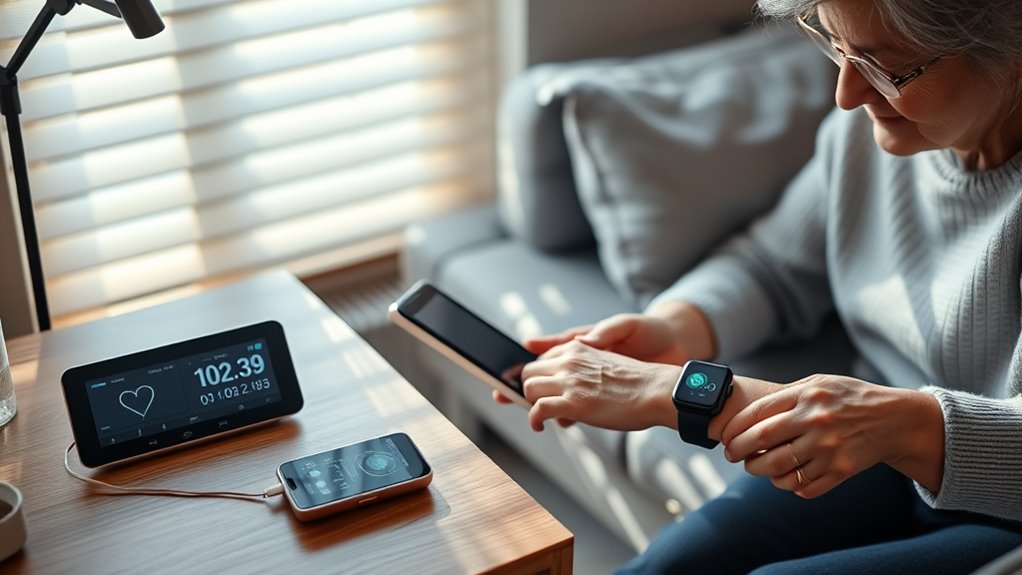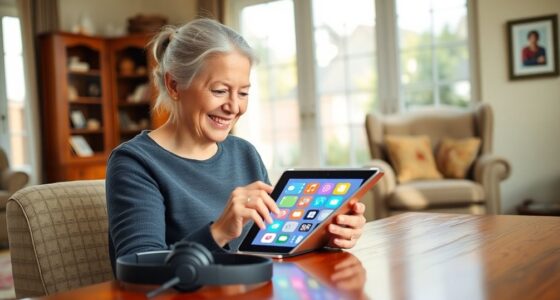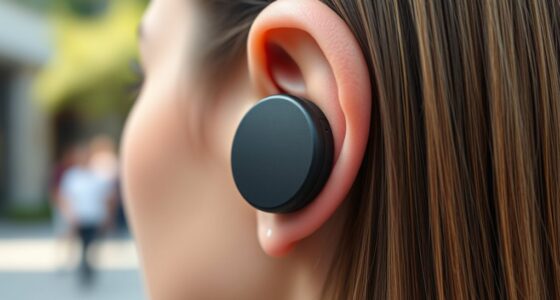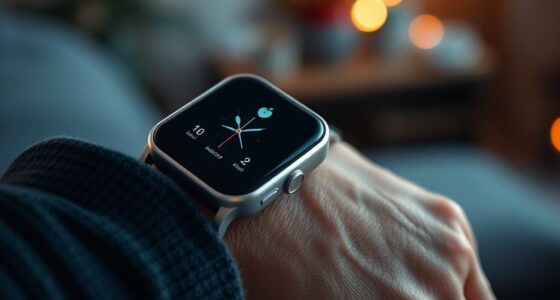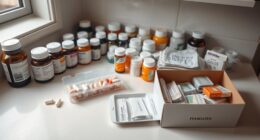Monitoring your essential signs at home helps you catch health issues early and stay in control of your wellness. Focus on tracking your heart rate, blood pressure, oxygen saturation, body temperature, and respiratory rate, as these provide key insights into your cardiovascular, respiratory, and overall health. Using remote tools allows for real-time data sharing and proactive care. Keep exploring to discover how these devices can make managing your health easier and more effective.
Key Takeaways
- Monitoring vital signs like heart rate, blood pressure, and oxygen saturation helps detect health issues early.
- Tracking temperature and respiratory rate provides insights into illnesses and respiratory or lung conditions.
- Continuous monitoring empowers individuals to manage their health proactively and share data with healthcare providers.
- Using devices such as smartwatches, blood pressure cuffs, and pulse oximeters simplifies regular health tracking at home.
- Regular vital sign tracking supports personalized care, trend analysis, and timely medical intervention when needed.

Have you ever wondered how staying on top of your health can become easier and more convenient? With remote vitals monitoring at home, you can keep a close eye on your well-being without constant visits to the doctor’s office. Modern technology makes it possible to track essential health metrics right from your living room, giving you real-time insights that can help catch potential issues early. This approach empowers you to take control of your health, reduce unnecessary trips, and communicate more effectively with your healthcare providers.
Monitor your health effortlessly at home with real-time insights using remote vitals technology.
When it comes to remote vitals monitoring, there are several key signs you should focus on. Heart rate and rhythm are fundamental indicators of your cardiovascular health. Devices like smartwatches or dedicated monitors can continuously record your pulse, alerting you to irregularities like arrhythmias or rapid heartbeat that might need medical attention. Blood pressure is another critical metric, especially for those managing hypertension or at risk of cardiovascular disease. Portable blood pressure cuffs connect to your phone or home hub, recording readings consistently and helping you track trends over time. Oxygen saturation levels, or SpO2, are vital during respiratory illnesses or chronic lung conditions. A pulse oximeter can easily measure this, providing instant feedback on how well your lungs are functioning.
Monitoring your body temperature can also be essential, particularly during illness or flu season. Digital thermometers or wearable devices allow you to quickly check your temperature and notice any unusual fever patterns. Additionally, tracking your respiratory rate—how many breaths you take per minute—can be important, especially if you have lung or heart conditions. Some advanced devices can measure this automatically, giving you a detailed picture of your respiratory health. Furthermore, incorporating AI-powered health data analysis can help interpret your vital signs more accurately, alerting you to subtle changes that might otherwise go unnoticed.
Tracking these vital signs matters because it allows you to identify potential health issues early, often before symptoms become severe. For example, a sudden spike in blood pressure or irregular heartbeat can signal a problem that requires medical intervention. By having this data, you and your healthcare provider can make more informed decisions about your treatment plan. It also helps you see how lifestyle changes, medication, or treatment adjustments are affecting your health over time.
Incorporating remote vitals monitoring into your routine means you’re actively participating in your health management. It promotes proactive care, reduces the need for frequent doctor visits, and provides peace of mind. With all these tools at your fingertips, staying on top of your health becomes not only easier but more personalized and responsive to your unique needs.
Frequently Asked Questions
How Secure Is My Data During Remote Vitals Monitoring?
Your data security depends on the device and platform you use. Reputable remote essential monitoring systems employ encryption and secure data transmission to protect your information. Always choose devices with strong security features, keep software updated, and use secure Wi-Fi networks. You also have a role in safeguarding your data by regularly changing passwords and being cautious with sharing information, ensuring your health data stays private and protected.
Can Remote Monitoring Replace Regular Doctor Visits Entirely?
No, remote monitoring can’t replace your regular doctor visits entirely. While it’s incredible for catching issues early and managing chronic conditions, it can’t replace the personalized care, physical exams, and nuanced judgments only your doctor provides. Think of remote monitoring as a powerful tool that enhances your healthcare, but you still need those in-person visits for a complete picture and peace of mind. It’s a team effort, not a solo act.
What Devices Are Most Accurate for Home Vital Tracking?
You should consider using FDA-approved devices like the Omron Platinum for blood pressure, a pulse oximeter such as the Masimo MightySat for oxygen levels, and a reliable digital thermometer for temperature. Wearable fitness trackers like Fitbit or Apple Watch can also monitor heart rate and activity. Guarantee the devices you choose are validated for accuracy, easy to use, and connect smoothly to your smartphone or healthcare provider for reliable readings.
How Do I Troubleshoot Technical Issues With Monitoring Devices?
You notice your device isn’t working properly, so start by checking the batteries or power source—sometimes, that’s all it takes. Confirm the device is properly connected or paired with your phone or display unit. Restart the device and update any software or apps. If issues persist, consult the user manual or contact customer support. Regular troubleshooting guarantees your essential monitoring remains accurate and reliable, giving you peace of mind.
Are There Specific Conditions That Benefit Most From Remote Vitals Monitoring?
You’ll find that conditions like hypertension, heart disease, diabetes, and respiratory issues benefit most from remote vital signs monitoring. It helps you and your healthcare provider track your health trends closely, catch potential problems early, and adjust treatments promptly. If you have a chronic condition, regular monitoring offers peace of mind, better management, and can prevent complications, making it an essential tool for staying on top of your health.
Conclusion
By tracking your essential signs at home, you’re taking control of your health like never before. Monitoring things like heart rate, blood pressure, and oxygen levels can catch issues early and potentially save your life. Think of it as having a medical superhero right in your living room, fighting off health threats before they escalate. Don’t underestimate the power of knowing your body—because staying informed could be the difference between good health and a crisis.
